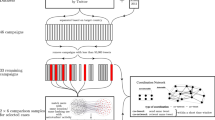Abstract
Politicians use social media to engage and communicate with voters, in particular during election campaigns. This article investigates data collected from politicians’ Facebook pages during the 2013 Australian Federal election and the 2013 Malaysian General election. We wish to gain insight into whether the likes and comments of Facebook users reflect actual connections between politicians during an election campaign. Intuitively, a Facebook user who supports a particular party would not like the posts published by candidates who are associated with opposing parties. However, we observe that users often like the posts by candidates belonging to opposing parties. Our analysis of the data shows that many of the likes and comments made by Facebook users are statistically insignificant. Deletion of these insignificant likes and comments clearly reveals the different parties of the political system. In this paper we consider only the topology of the network representing the datasets, presenting an alternative to the often cumbersome sentiment analysis.
Access this chapter
Tax calculation will be finalised at checkout
Purchases are for personal use only
Preview
Unable to display preview. Download preview PDF.
Similar content being viewed by others
References
Australian Greens, “Our Policies.” [Online]. Available: http://greens.org.au/policy
Australian Sex Party, “Our Policies.” [Online]. Available: http://www.sexparty.org.au/policies
F. P. Barclay, C. Pichandy, A. Venkat, and S. Sudhakaran, “India 2014: Facebook ’like’ as a predictor of election outcomes,” Asian Journal of Political Science, vol. 23, no. 2, pp. 134–160, 2015.
J. Bronstein, “Like me! Analyzing the 2012 presidential candidates’ Facebook pages,” Online Information Review, vol. 37, no. 2, pp. 173–192, 2013.
G. Davies, “Bob Katter and the world.” [Online]. Available: https://independentaustralia.net/politics/politics-display/bob-katter-and-the-world,5826
A. Elter, “Interaktion und Dialog? Eine quantitative Inhaltsanalyse der Aktivit¨aten deutscher Parteien bei Twitter und Facebook w¨ahrend der Landtagswahlk¨ampfe 2011,” Publizistik, vol. 58, pp. 201–220, 2013.
G. S. Enli and E. Skogerbø, “Personalized campaigns in party-centred politics,” Information, Communication & Society, vol. 16, no. 5, pp. 757–774, 2013.
C. Gerlitz and A. Helmond, “The like economy: Social buttons and the data-intensive web,” New Media & Society, vol. 15, no. 8, pp. 1348–1365, 2013.
R. Gerodimos and J. Justinussen, “Obamas 2012 Facebook campaign: Political communication in the age of the like button,” Journal of Information Technology & Politics, vol. 12, no. 2, pp. 113–132, 2015.
T. Graham, M. Broersma, K. Hazelhoff, and G. van ’t Haar, “Between broadcasting political messages and interacting with voters,” Information, Communication & Society, vol. 16, no. 5, pp. 692–716, 2013.
I. Himelboim, S. McCreery, and M. Smith, “Birds of a feather tweet together: Integrating network and content analyses to examine cross-ideology exposure on Twitter,” Journal of Computer-Mediated Communication, vol. 18, no. 2, pp. 40–60, 2013.
A. O. Larsson, “Online, all the time? A quantitative assessment of the permanent campaign on Facebook,” New Media & Society, vol. 18, no. 2, pp. 274–292, 2014.
J. Liebig and A. Rao, “Fast extraction of the backbone of projected bipartite networks to aid community detection,” EPL, vol. 113, no. 2, p. 28003, 2016.
A. Livne, M. P. Simmons, E. Adar, and L. A. Adamic, “The party is over here: Structure and content in the 2010 election,” ICWSM, vol. 11, pp. 17–21, 2011.
Malaysiakini, “Ibrahim Ali out, Saifuddin Abdullah in.” [Online]. Available: https: //www.malaysiakini.com/news/226970
Z. Neal, “The backbone of bipartite projections: Inferring relationships from co-authorship, co-sponsorship, co-attendance and other co-behaviors,” Social Networks, vol. 39, no. 1, pp. 84–97, 2014.
M. E. J. Newman, “Finding community structure in networks using the eigenvectors of matrices,” Physical Review E, vol. 74, no. 3, p. 036104, 2006.
E. Skogerbø and A. H. Krumsvik, “Newspapers, Facebook and Twitter,” Journalism Practice, vol. 9, no. 3, pp. 350–366, 2015.
T. L. Towner, “All Political Participation Is Socially Networked?: New Media and the 2012 Election,” Social Science Computer Review, vol. 31, no. 5, pp. 527–541, 2013.
A. Tumasjan, T. O. Sprenger, P. G. Sandner, and I. M. Welpe, “Election forecasts with Twitter: How 140 characters reflect the political landscape,” Social Science Computer Review, vol. 29, no. 4, pp. 402–418, 2010.
Author information
Authors and Affiliations
Corresponding author
Editor information
Editors and Affiliations
Rights and permissions
Copyright information
© 2017 Springer International Publishing AG
About this paper
Cite this paper
Liebig, J., Khairuddin, M.A., Rao, A. (2017). Online election campaigning: Identifying political parties using likes and comments. In: Cherifi, H., Gaito, S., Quattrociocchi, W., Sala, A. (eds) Complex Networks & Their Applications V. COMPLEX NETWORKS 2016 2016. Studies in Computational Intelligence, vol 693. Springer, Cham. https://doi.org/10.1007/978-3-319-50901-3_49
Download citation
DOI: https://doi.org/10.1007/978-3-319-50901-3_49
Published:
Publisher Name: Springer, Cham
Print ISBN: 978-3-319-50900-6
Online ISBN: 978-3-319-50901-3
eBook Packages: EngineeringEngineering (R0)




